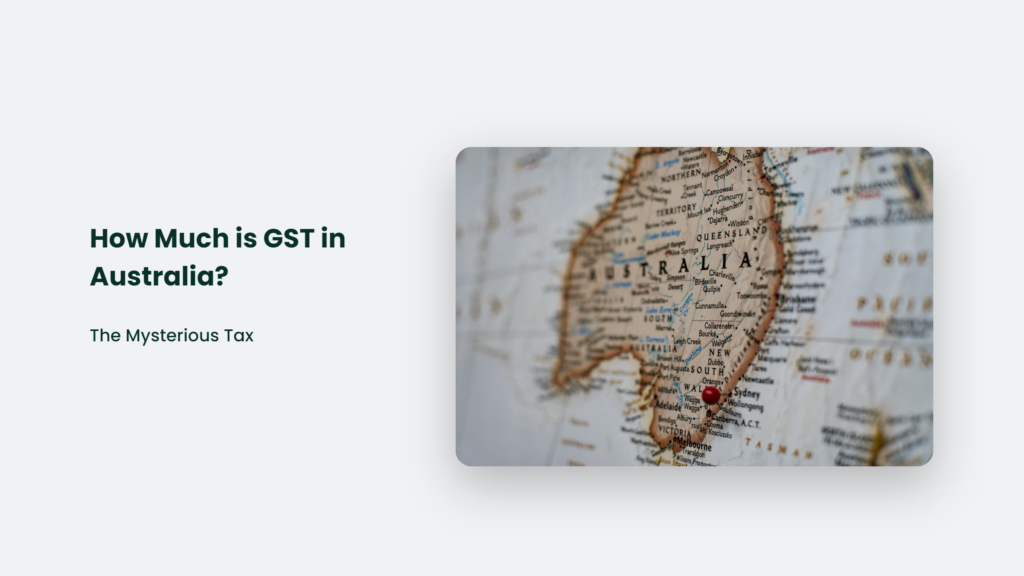

How Much is GST in Australia? The Mysterious Tax

As Seen On
Let’s face it – talking about taxes is as fun as getting a root canal while watching C-SPAN.
But if you’re an Australian, GST is like that one crazy relative who shows up at every family gathering and makes things simultaneously uncomfortable and entertaining. You can’t get rid of them, so you might as well embrace the madness.
And if you’re wondering what the GST tax rate is, how much is GST in Australia or how the hell this thing even works, don’t worry; I’ve got your back. By the time we’re done here, you’ll be a GST expert ready to do your taxes while chugging a VB.So, let’s dive into this magical world of GST together…hope you brought your flippers because the bullshit is deep.

What is GST in Australia?
GST stands for Goods and Services Tax. It’s a value-added tax of 10% on most goods and services sold in Australia.
It was introduced in 2000 by the Howard Government to replace a bunch of complicated sales taxes with one simple, broad-based tax.
The idea is that GST would apply to all stages of production and distribution, ultimately passed on to the final consumer.
So, if you buy a widget for $100 as an individual consumer, you pay $110 ($100 + $10 GST). But GST is collected throughout the supply chain, not just at the final sale.
This means producers, wholesalers, and retailers all charge 10% GST when they sell items to the next person in the chain. But they get credits for the GST they paid, so the only person who doesn’t get it back is the final buyer – you.
It’s like a hot potato of tax that gets passed around until it lands in your lap. What a fun game!
A Brief History of GST in Australia
Australia didn’t always have a GST. Prior to 2000, we had a bunch of federal and state sales taxes that made doing taxes more complicated than open heart surgery.
There was a whole mess of random taxes on sales, payrolls, insurance premiums, you name it. Some states even charged banks just for being banks. Strange times.
So in 1998, the Howard Government decided to scrap this clusterfuck of taxes and introduce one simple, easy-to-understand GST.
And what a glorious day it was! Australians rejoiced in the streets at the prospect of doing simpler taxes. Just kidding, there were massive protests and riots and even a new political party – One Nation – vehemently opposing it.
But eventually, we all got used to it. And now the GST is just one of those annoying things in life we learn to tolerate, like mosquitos and Nickelback albums.
How much is GST in Australia?
At its core, GST is pretty simple – it’s a 10% tax applied to most goods and services sold in Australia. But some twists and turns make it more confusing than your average tax.
Let’s break it down:
10% Tax Rate
The GST rate itself is just 10%. Easy enough. But hang on to your hats, folks…
Broad Base, Few Exemptions
Unlike sales taxes in other countries, GST applies broadly to most goods and services. There are exemptions for certain essentials like:
- Fresh food
- Medical services & products
- Education
- Childcare
- Water and sewerage
But otherwise, GST applies to most transactions – it has a very wide base.
Regressive Tax
Because it applies broadly to consumption, GST is considered a regressive tax – meaning it impacts lower-income earners more than higher-income earners as a percentage of their income.
But Australia has avoided some of this impact by exempting essentials like food.
Collected at Every Stage
Here’s the crazy part – GST is collected at every stage of production and distribution, not just at the final sale.
So if a farmer sells wheat to a baker for $100, they charge 10% GST and remit $10 to the ATO.
The baker pays $110 but claims that $10 back as a GST credit. And so on until it reaches the final customer.
It makes compliance more complex but also makes it harder to evade.
Zero-Rating of Exports
To encourage exports, goods and services sold overseas are zero-rated – no GST is applied.
It helps Aussie businesses stay competitive globally.
Quarterly Reporting
GST is reported and paid quarterly, not annually, like income tax. So the paperwork comes around four times a year, whether you’re ready or not.
GST Registration in Australia
If you’re running a business in Australia, you must register for GST if your annual turnover is over $75,000. Below this threshold, you can register voluntarily to claim GST credits. Once registered, you need to:
- Charge 10% GST on taxable sales
- Collect GST on sales
- Claim GST credits on business purchases
- Report and remit GST quarterly
So registering opens up both obligations and benefits. You can claim credits for the GST you pay, but you must also take on the admin work of collecting and reporting it.
GST Reporting & Compliance
One of the trickier parts of GST for Australian businesses is keeping up with reporting and compliance obligations:
- You must file a Business Activity Statement (BAS) each quarter with the ATO to report the total GST collected and any GST credits.
- GST must be remitted to the ATO by the due date, usually 28 days after the end of the quarter.
- Businesses need to keep detailed records of all taxable sales and purchases to track GST collected and credits. It includes tax invoices, receipts, and accounting records.
- Penalties can apply for late payment of GST liabilities or GST fraud. Interest is charged on late payments.
- Businesses can face ATO audits and reviews to ensure GST compliance. Record-keeping is critical in case of an audit.
- Special rules apply in some cases like long-term contracts, insurance, financial supplies, property transactions, etc.
- Businesses with turnover under $10 million can use cash accounting to simplify GST reporting.
So, in summary, GST adds an ongoing compliance burden to Australian businesses. There are many record-keeping requirements and quarterly reporting obligations. Failing to meet these can lead to penalties from the ATO.
Tips for Managing GST Compliance
Here are some tips businesses can use to stay on top of GST compliance:
- Use accounting software that handles GST calculations and reporting automatically. It avoids manual errors.
- Link your software to the ATO portal so BAS reports can be lodged digitally.
- Have clear processes for issuing tax invoices and record-keeping. Don’t mix up taxable sales and exempt sales.
- Train staff on GST requirements and procedures.
- Get expert advice on GST for complex transactions like imports/exports.
- Review compliance performance each quarter and annually to improve.
- Set up reminders for BAS deadlines so payments are made on time.
- Keep everything! Documentation is crucial in case of an ATO audit.
These tips will help your business properly manage GST reporting and avoid penalties.
Common GST Mistakes in Australia
Despite having over 20 years to get used to it, many Australian businesses still make mistakes with GST. Some common errors include:
Failing to register for GST when turnover exceeds the threshold
- Not charging GST on taxable sales
- Incorrectly claiming GST credits for non-creditable purchases
- Not issuing valid tax invoices for sales
- Calculating GST incorrectly
- Failing to report and pay GST on time
- Poor record-keeping overall
These kinds of mistakes can attract ATO penalties and interest charges. For larger businesses, poor GST compliance can even risk tax audits and criminal charges in extreme cases.
So, it pays to get your GST ducks in a row as an Australian business. Put good processes and software in place to avoid silly mistakes.
GST and Overseas Suppliers
As cross-border e-commerce grows, managing GST on imports has become a bigger issue.
Overseas suppliers don’t have to charge GST when selling to Australian consumers under $1,000.
It gives them a price advantage over local suppliers who charge GST.
To level the playing field, the government has introduced measures like:
- Imposing GST on overseas sales over $1,000
- Forcing platforms like Amazon to collect GST on behalf of sellers
- Using data matching to identify overseas purchases
However, there are still issues enforcing GST on any imports under $1,000. This threshold may be lowered over time as technology improves.
Frequently Asked Questions:
How do I charge GST on sales?
Add 10% GST to the listed price of taxable goods and services. The total price charged is the GST-inclusive price.
How often do I report GST to the ATO?
GST obligations are reported quarterly on your BAS, which is usually due 28 days after quarter end.
Are there different GST rules for imports and exports?
Yes, exports are zero-rated but imports have complex rules depending on value and origin.
In Conclusion
You’re probably exhausted after this epic journey through the wonderfully weird world of GST in Australia. I don’t blame you – GST is convoluted as hell.
But now you’ve got a solid grasp of how this consumption tax works, from its broad 10% rate to its messy quarterly reporting requirements.
You understand who has to register, what’s taxable, how to charge GST, and how to claim credits. And you’ve learned some tips to avoid common mistakes.
While GST may seem annoying, its revenue funds critical government services for all Australians. So we’ve just got to take the good with the bad.
And for Aussie businesses, managing GST properly is now part of doing business Down Under. Consider it an initiation ritual, like wrestling crocodiles or drinking VB.
Sure, GST is a pain in the butt. But we Australians are a resilient bunch. We’ve survived GST for over 20 years already. We’ll get through this together, one quarterly BAS at a time.
So take a deep breath, get your GST shit sorted, and we’ll all be okay. Let’s grab a cold one at the pub when this is all over.
Konger
Up until working with Casey, we had only had poor to mediocre experiences outsourcing work to agencies. Casey & the team at CJ&CO are the exception to the rule.
Communication was beyond great, his understanding of our vision was phenomenal, and instead of needing babysitting like the other agencies we worked with, he was not only completely dependable but also gave us sound suggestions on how to get better results, at the risk of us not needing him for the initial job we requested (absolute gem).
This has truly been the first time we worked with someone outside of our business that quickly grasped our vision, and that I could completely forget about and would still deliver above expectations.
I honestly can't wait to work in many more projects together!
Disclaimer
*The information this blog provides is for general informational purposes only and is not intended as financial or professional advice. The information may not reflect current developments and may be changed or updated without notice. Any opinions expressed on this blog are the author’s own and do not necessarily reflect the views of the author’s employer or any other organization. You should not act or rely on any information contained in this blog without first seeking the advice of a professional. No representation or warranty, express or implied, is made as to the accuracy or completeness of the information contained in this blog. The author and affiliated parties assume no liability for any errors or omissions.

